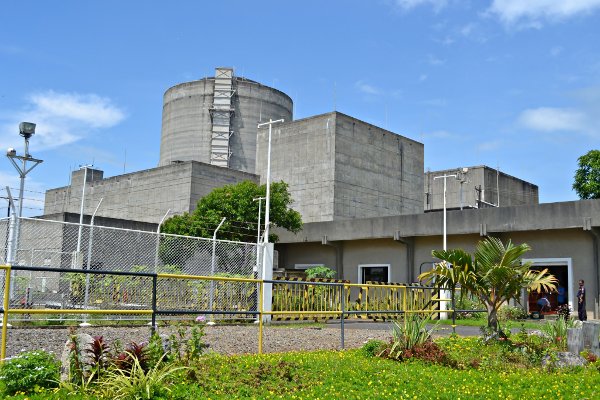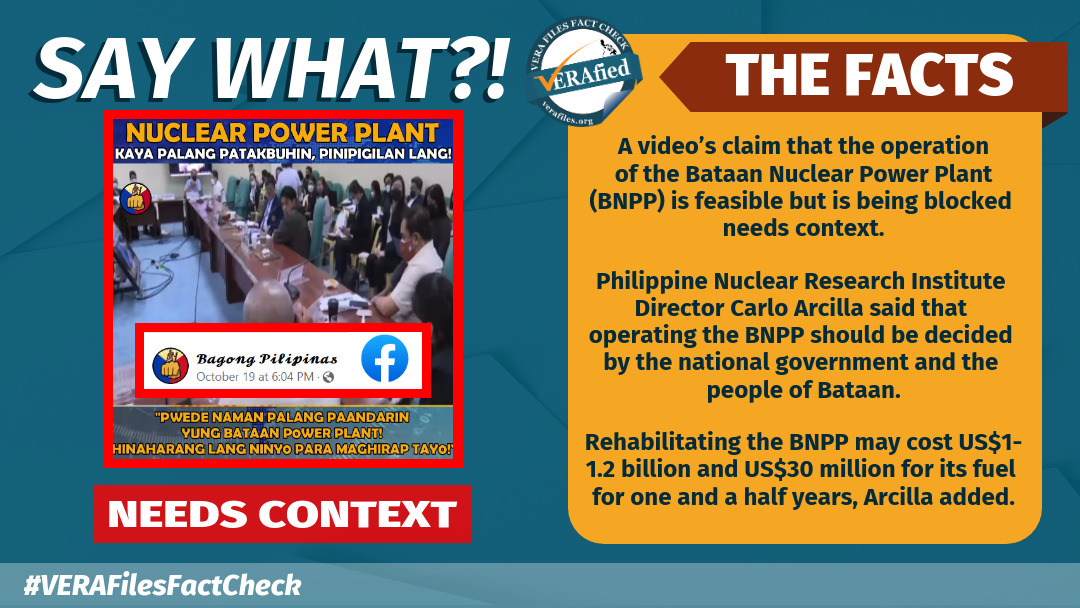Sen. Nancy Binay sought a “comprehensive study” on “what to do” with the almost four-decade-old mothballed Bataan Nuclear Power Plant (BNPP) during a Senate committee hearing last Oct. 13 on the proposed budget for 2021 of the Department of Energy (DOE).
In response, Energy Secretary Alfonso Cusi told the senators that nuclear experts from Russian and South Korean firms have submitted proposals in 2017, saying that the BNPP “can still be revived.”
Binay voiced her concern that the government was wasting too much money on the upkeep of the idled nuclear power plant.
During the hearing, Sen. Sherwin Gatchalian, chairman of the committee on energy, noted that for the maintenance of the BNPP, the state-owned National Power Corp. (Napocor) proposed a 76.92 percent budget increase, from P52 million for 2020 to P92 million for 2021.
President Rodrigo Duterte has ordered a consultation with the residents of Bataan on the possible revival of the BNPP, according to Presidential Spokesperson Harry Roque in his press briefing on Oct. 1 in the province.
In Executive Order No. 116 signed on July 24, Duterte created an inter-agency committee tasked to “conduct a study for the adoption of a national position on a Nuclear Energy Program (NEP).” The panel was authorized, among others, “to evaluate and assess the need for and viability of introducing nuclear power” into the country’s energy mix, including existing facilities but “not limited” to the BNPP.
The 11-member Nuclear Energy Program Inter-Agency Committee (NEP-IAC), with the Department of Energy (DOE) as lead agency, has been given six months or until January 2021 to present its initial reports to the Office of the President. Thereafter, NEP-IAC should submit its succeeding findings every six months.
The first and only nuclear power plant in the Philippines, the BNPP never operated due to safety concerns and issues of corruption and cronyism under the late dictator Ferdinand Marcos Sr.’s regime.
Here are three things you should know about the BNPP.
What is Bataan Nuclear Power Plant?
Four years after Marcos declared Martial law, the construction of the 620-megawatt BNPP began in 1976, in response to the 1970s energy crisis. This aimed to lower the country’s dependence on imported oil and develop an alternative source of electricity for the Luzon grid.
Initially priced at US$500 million by Westinghouse Electric Co. in a “vague, undetailed bid for two nuclear plants,” the cost had ballooned to US$2.3 billion when it was finished in 1984.
Three years into building the BNPP, the project was temporarily halted in 1979 after a nuclear accident in Three Mile Island, Pennsylvania, U.S.A. This prompted the Philippine government to reexamine the safety of its own nuclear plant, creating a commission in June 1979 to investigate the “dangers that may arise from the operation of the proposed nuclear power plant.” Marcos appointed then Justice Minister Ricardo Puno and former senator Lorenzo Tañada, an anti-nuclear activist, to co-chair the Commission on the Safety of the Bataan Nuclear Power Plant. After Tañada declined the appointment, Marcos designated Puno as head of the commission, with then retired justices Conrado Vasquez and Jose Bautista as members.
In a report submitted in November 1979, the Commission said the nuclear power plant had “inadequate safeguards and could be a potential hazard to the health and safety of the public.” It also cited many defects in construction and design, including unassured storage of nuclear waste.
Upon the invitation of Tañada, Nuclear engineer Robert Pollard from the Union of Concerned Scientists (USC) also submitted an affidavit to the Commission, saying that based on his study on the BNPP, the plant is “not safe and will not be inexpensive.” He later spoke before the Rotary Club of Manila, repeating his claim.
Despite the recommendations of the three-man commission, Marcos still ordered the resumption of the construction of the gigantic infrastructure in January 1981, with a renegotiated contract with Westinghouse — supposedly incorporating more than 100 regulatory safety requirements.
As protests began to mount against the BNPP, Marcos was ousted in the 1986 People Power Revolution.
The BNPP was mothballed by then President Corazon “Cory” Aquino in November 1986 through Executive Order 55, citing safety and economic reasons. This was seven months after the Soviet Union’s Chernobyl nuclear power plant explosion. (See VERA FILES FACT CHECK: Gadon’s claim on reason of Cory Aquino for stopping BNPP operation FALSE)
The blast instantly killed two persons, while at least 28 others died from acute radiation exposure in the course of three months. In a 2005 joint news release, the United Nations and World Health Organization predicted more than 4,000 more deaths from exposure to radiation.
In EO 55, Aquino designated the National Power Corp. as caretaker to oversee the “preservation, maintenance and security” of the BNPP until “final disposal and/or utilization of the plant” is decided.
The Philippine government continues to pay some P40 to 50 million a year for its maintenance. In 2011, the BNPP became a tourist attraction.
What issues are hounding the mothballed power plant?
Marcos and his confidants were reported to have pocketed millions of dollars from the Westinghouse and Burns and Roe contract brokered by crony businessman Herminio Disini.
Disini was one of Marcos’ golf partners and husband of Paciencia Escolin, a first cousin and personal physician of former First Lady Imelda Marcos.
The government awarded Westinghouse the BNPP contract even without a concrete document bid. General Electric, which was already in talks with Napocor before the former manufacturing company came into picture, had a cheaper counterpart offer. The budget for the power plant was loaned from the United States Export-Import Bank.
Proofs of bribery were discovered from financial documents of ill-gotten wealth after the Marcos family fled Malacañang at the height of the “people power” revolution in February 1986. Disini allegedly received millions in kickbacks from Westinghouse Electric Co.
The manufacturing company argued that Disini received a “legitimate sales commission.”
After the ouster of Marcos in 1986, the Philippine government pursued a case against Westinghouse and Burns and Roe for bribery and overpricing, but lost as a United States court dismissed the suit.
In 2013, the Supreme Court affirmed that the anti-graft court Sandiganbayan has jurisdiction to litigate cases against Disini on the Bataan plant. A year earlier, the Sandiganbayan declared as “ill-gotten” the US$50.6 million “commission” Disini received from Westinghouse and Burns and Roe for brokering the BNPP deal, and ordered him to “reconvey” the amount to the Philippine government.
Nearly 32 years since the BNPP was completed, the Filipinos finished paying the loans and interests in 2007. The government has paid a total of P64.7 billion (P43.5 billion for principal amortization and P21.2 billion in interest) for the nuclear power plant that never generated a single watt of electricity.
For critics, the BNPP serves as a “symbol” of Marcoses’ 20 years of corrupt rule.
Is it safe and economical to operate the Bataan Nuclear Power Plant at this time?
In 2017, the DOE invited experts from Korea and Russia to conduct a pre-feasibility study on the integrity of the BNPP infrastructure. Proposals submitted to rehabilitate the nuclear power plant would cost between US$1 billion for the Korean firm — that will take up to four years — and US$2 to US$3 billion for the Russian company.
During the Oct.13 Senate hearing, Cusi said that although the feasibility inquiries had been done, the Philippine government has yet to conduct a “concrete study” on the BNPP. He added that his agency will come up with a budget estimate, taking into account Binay’s proposal for a “comprehensive study” on the viability of the nuke plant.
In an interview with CNN’s The Source in 2018, Russian Ambassador Igor Khovaev said as far as he knows, the BNPP’s technology of the plant was “absolutely outdated” and international standards are now “much higher.”
Yet, according to Carlo Arcilla, director of the Philippine Nuclear Research Institute (PNRI), an agency under the Department of Science and Technology (DOST) mandated to undertake research and development on peaceful uses of nuclear tech, BNPP is “younger,” compared with other nuclear plants in America.
He said experts from Russian nuclear firm Rosatom State Atomic Energy Corporation told him that their Russian ambassador “made a mistake” in his remarks about the BNPP.
The Bataan plant has nuclear reactors with the same design in South Korea, Slovenia, and Brazil that are still running, according to Arcilla. The PNRI chief said the Korean experts assured him that they can revive the nuclear plant because they have an exact model in their country.
On fears of having another Chernobyl accident, Arcilla said it was a “Soviet design” reactor unlike the “western style” of BNPP.
“Lahat po ng nuclear plants na Western design…may takip. Ang tawag d’yan, containment structure. Kung sakaling may aksidente, ‘di kakalat. ‘Yung nandun pong dating Chernobyl, walang ganyan.”
(All nuclear power plants with Western design…have cover. It’s called containment structure. In case of accidents, [the radiation] will not spread. The old Chernobyl did not have that).
Source: ABS-CBN News YouTube, Bataan nuclear plant can still operate, says PH nuclear research body, Oct. 3, 2020. watch from 9:00 to 9:12
However, in the interview, it was also pointed out that the nuclear power plants with the same design in Korea, Slovenia, and Brazil were still operating since the beginning, compared with the BNPP, which was never used.
Another reason for stopping the operation of BNPP in 1986 was its proximity to Mt. Natib volcano.
However, the Philippine Institute of Volcanology and Seismology (Phivolcs) said the possibility of a volcanic eruption is low and that BNPP is situated on higher ground less likely to be affected by a tsunami similar to the Fukushima meltdown in 2011. Phivolcs added that the Iba, Zambales fault is 60 kilometers away.
In an interview on UNTV in 2016, Phivolcs chief Renato Solidum said tests done on charcoal deposits have revealed that Mt. Natib’s last eruption was 27,000 years ago. Phivolcs classifies Mt. Natib as “potentially active,” which means “young-looking but with no historical or analytical records of eruption.”
However, the nuclear waste for the BNPP remains a problem, Filipino scientist Fabian Dayrit, an academician of the National Academy of Science and Technology, told ANC Matters of Fact in an interview on Oct. 7.
Dayrit said nuclear energy “is not sustainable” as it requires the importation of nuclear fuel. He added that after a nuclear power plant reaches its maximum lifespan of 40 years, the decommissioning and maintenance of nuclear waste “for many years” might be expensive.
Here’s a part of the interview:
“Q: So in the long term, this could cost us a lot more money, even if it can lower the price of electricity.
Dayrit: Well, that might be possible. You are sort of charging the cost of decommissioning to the future generations. That’s not really a good thing to leave to your children and grandchildren, they might pay for decommissioning and nuclear waste.”
Source: ABS-CBN News YouTube, No place for nuclear waste: Top Filipino scientist nixes nuke plant revival | ANC, Oct. 7, 2020. watch from 5:25 to 6:00
Sources
Senate of the Philippines YouTube, Committee on Finance [Subcommittee “E”], Oct. 13, 2020
Department of Energy, Press Release: PHL, Russia Ink Technical Assistance Cooperation on Nuclear, Nov. 15, 2017
State Atomic Energy Corporation Rosatom, About us
GMA News Online, Bataan nuclear plant can be revived, says Russian state firm Rosatom, May 13, 2018
Business Mirror, BNPP can be rehabbed, experts say, Jan. 15, 2018
The Manila Times, Research institute calls for revival of Bataan nuke plant, Dec. 27, 2018
Manila Bulletin, BNPP in ‘good condition’ for $1-B rehab cost – study, Sept. 5, 2019
House of Representatives YouTube, 18th CONGRESS 2nd REGULAR SESSION #09 : H.B 7727 – 2021 General Appropriation Bill (Day 4 Pt.1), Oct. 1, 2020
Office of the Presidential Spokesperson, Press Briefing of Presidential Spokesperson Harry Roque, Oct. 1, 2020
PTV YouTube, WATCH: Palace virtual presser with Presidential Spokesperson Harry Roque, Oct. 1, 2020
Official Gazette of the Philippines, Executive Order No. 116: Directing a study on National position on a nuclear energy program, July 24, 2020
Department of Energy, 2019 Power Situation Report, Retrieved on Oct. 24, 2020
Lawphil.net, Supreme Court En Banc, G.R. No. L-68474: Nuclear Free Philippine Coalition Et. Al v. National Power Corporation & G.R. No. 70632: Lorenzo Tañada v. Philippine Atomic Energy Commission
Chan Robles, Supreme Court En Banc, G.R. No. L-68474: Nuclear Free Philippine Coalition Et. Al v. National Power Corporation & G.R. No. 70632: Lorenzo Tañada v. Philippine Atomic Energy Commission
Martial Law Chronicles Project, CORRUPTION UNDER MARTIAL LAW | Marcos and his ‘temple of doom’, Jan. 25, 2016
History of Bataan Nuclear Power plant
- Official Gazette of the Philippines, Special Feature: Declaration of Martial Law
- Official Gazette of the Philippines, Administrative Order No. 293: Creating the Coordinating Committee for Nuclear Power Study, June 23, 1971
- International Atomic Energy Agency, A Primer on the Bataan Nuclear Power Plant. Retrieved on Oct. 24, 2020
- Official Gazette of the Philippines, Special Feature: The Fall of the Dictatorship
- Official Gazette of the Philippines, Official Week in Review: July 27 – August 2, 1973, Aug. 6, 1973
- The Guardian, Background: What caused the 1970s oil price shock?, March 3, 2011
- Organization of the Petroleum Exporting Countries, Brief History
- Office of Scientific and Technical Information, Philippines: Asia Pacific energy series: Country report
- Ichord, R. (1974). SOUTHEAST ASIA AND THE WORLD OIL CRISIS: 1973. Southeast Asian Affairs, pg. 27-56. Retrieved on October 24, 2020
- International Atomic Energy Agency, Nuclear Power Prospects in the Philippines, Dec. 31, 1970
- International Atomic Energy Agency, Progress in Peaceful Applications of Nuclear Energy during the year 1966/1967, pg. 25 to 29, April 1968
- The New York Times, Marcos, Facing Criticism, May End $1 Billion Westinghouse Contract, Jan. 14, 1978
- Beaver, W. (1994). Nuclear Nightmares in the Philippines. Journal of Business Ethics, 13(4), pg. 271-279, Retrieved on Oct. 24, 2020
- CNN Money, THE $2.2 BILLION NUCLEAR FIASCO Westinghouse’s Philippine power plant is a management nightmare, and it isn’t even running. The Aquino government charges that the company bribed Ferdinand Marcos and did sloppy work. It wants restitution, Sept. 1, 1986
- Britannica Encyclopedia, Three Mile Island accident, Jul 20, 1998
- United States Nuclear Regulatory Commission, Backgrounder on the Three Mile Island Accident, June 21, 2018
- The Balance, The Three Mile Island Nuclear Accident and Its Impact on U.S. Energy, Jan. 31, 2020
- Official Gazette of the Philippines, Letter of Instruction No. 876: Chairman and Co-Chairman conduct an inquiry on safety of the Bataan Nuclear Power Plant, June 16, 1979
- Official Gazette of the Philippines, Executive Order No. 539: Creating a commission to conduct an inquiry on the safety to the public of all nuclear plants in the country, June 15, 1979
- Bantayog.org, Tanada letter to Marcos on the Bataan Nuclear Power Plant (1979), July 21, 2015
- United States Nuclear Regulatory Commission, Report of the Commission: Inquiry on the Safety to the Public of the Bataan Nuclear Plant (For Exec. Order No. 539, june 15, 1979), Nov. 16, 1979
- Official Gazette of the Philippines, Letter of Instruction No. 957: In view of these findings, it will not be possible to continue with the construction of the Bataan Nuclear Plant…, Nov. 13, 1979
- Cardenas, B. (1987). The Bataan Nuclear Power Plant: Three Episodes of Decision Making. Philippine Journal of Public Administration Vol. XXXI, No. 3 (July 1987) pg. 279-296, Retrieved on Oct. 24, 2020
- The Christian Science Monitor, Sparks fly over Philippine nuclear plant, Nov. 30, 1984
- New Scientist, Reactor row, Aug. 10, 1991
- United States Nuclear Regulatory Commission, NRC investigates employee’s allegations, Jan. 20, 1976
- National Cable Satellite Corporation, Robert Pollard
- The New York Times, Gate Crasher Shakes Up Nuclear Debate, Feb. 11, 1993
- Schirmer, D. B., & Shalom, S. R. (1987). The Philippines reader: A history of colonialism, neocolonialism, dictatorship, and resistance, pg. 175. Retrieved on Oct. 24, 2020
- Department of Energy, Nuclear Energy for Power Generation, February 2016
- ABS-CBN News, Timeline: Nuclear Power in the Philippines, Dec. 21, 2009
- Beaver, W. (1994). Nuclear Nightmares in the Philippines. Journal of Business Ethics, 13(4), 271-279. Retrieved on Oct. 24, 2020
- Global Nonviolent Action Data, Filipinos protest against Bataan Nuclear Power Plant and U.S. military bases, 1983-1986, Retrieved on Oct. 24, 2020
- The Washington Post, The Nuclear Accident, May 1, 1986
- Official Gazette of the Philippines, Executive Order No. 55: Transferring to the national government the Philippine Nuclear Power Plant I…, Nov. 4, 1986
- The Atlantic, The Chernobyl Disaster: 25 Years Ago, March 23, 2011
- Britannica Encyclopedia, Chernobyl disaster, July 20, 1998
- World Nuclear Association, Chernobyl Accident 1986, April 2020
- Heavy.com, Chernobyl Deaths: How Many People Died at Chernobyl?, May 30, 2019
- World Health Organization, Joint News Release: 20 Years Later a UN Report Provides Definitive Answers and Ways to Repair Lives, Sept. 5, 2005
- United Nations, 20 Years Later, UN Report Provides Definitive Answers, Ways to Repair Lives, Sept. 5, 2020
- Philippine Nuclear Research Institute, NAST Statement on Nuclear Power in the Philippines, Oct. 23, 2019
- The New York Times, A Nuclear Plant, and a Dream, Fizzles, Feb. 13, 2012
- Discover Magazine, The Would-Be Nuclear Power Plant That Became a Tourist Attraction, Feb. 16, 2012
- BBC News, Philippines opens Bataan nuclear plant to tourists, July 24, 2011
Issues hounding the BNPP
- The New York Times, Filipinos say Marcos was given millions for ‘76 nuclear contract, March 7, 1986
- Los Angeles Times, $2.1 Billion Nuclear Plant, Never Used, Stands at Core of Philippines’ Debt Crisis, June 12, 1986
- Inquirer.net, Nuke plant bribery: PCGG wants Marcos, not just Disini, to pay, May 11, 2012
- The Washington Post, Marcos Orders Seizure of Wealthy Friends Companies, Jan. 18, 1978
- ABS-CBN News, BNPP broker Herminio Disini passes away, June 16, 2014
- The New York Times, Philippine President Orders Three Companies Sold, Jan. 17, 1978
- ABS-CBN News, Disini’s cousin, a crucial witness to Marcos illegal wealth cases, July 28, 2008
- GMA News Online, PCGG wants Disini cousin to testify in P51-B wealth case, Aug. 3, 2007
- The New York Times, A Westinghouse Memo Tells of Payment in Philippines, March 6, 1992
- The Washington Post, Marcos Papers Show Global Financial Web, March 21, 1986
- Los Angeles Times, Philippines Loses Bribery Suit Against Westinghouse : Energy: Charge of $26-million payoff for a nuclear power plant that has never operated is dismissed, May 19, 1993
- The Washington Post, Marcos Papers Show Global Financial Web, March 21, 1986
- Republic of Philippines v. Westinghouse Elec. Corp., 43 F. 3d 65 – Court of Appeals, 3rd Circuit 1994. Retrieved on Oct. 24, 2020
- GMA News Online, SC gives green light for Sandigan to try alleged Marcos crony, Sept. 30, 2013
- Inquirer.net, High court affirms cases vs Marcos crony Disini, Oct. 1, 2013
- Philstar.com, SC upholds Sandiganbayan jurisdiction on criminal cases vs Disini, Oct. 1, 2013
- Sandiganbayan First Division, Civil Case No. 0013 Decision: Republic of the Philippines v. Herminio Disini, et. al, April 11, 2012
- Inquirer.net, Mothballed plant cost $2.3 billion, Sept. 17, 2016
- Committee for the Abolition of Illegitimate Debt, Philippines: The Marcos debt, Nov. 5, 2018
- Philstar News Lab, 31 Years of Amnesia: Edifice Complex, Feb. 24, 2017
- Philippine Center for Investigative Journalism, Gloria’s inglorious record: Biggest debtor, least popular, Aug. 13, 2008
- Philippine Information Agency, Gov’t brings electricity to remotest barangays, says Energy chief, June 18, 2007
- Inquirer.net, BNPP, symbol of onerous loan under Marcos, back in discussion for PH nuke power, Oct. 15, 2019
- Inside Story, No power, but plenty of symbolism, Nov. 22, 2017
Safety and economics of Bataan Nuclear Power Plant
- The Manila Times, Rehab of Bataan nuclear power plant needs $1 billion, Feb. 2, 2010
- Reuters.com, In power hungry Philippines, some advocate a nuclear revival, May 23, 2018
- The Asean Post, Philippines considering nuclear energy, Dec. 25, 2019
- CNN Philippines, Russian ambassador: Bataan nuclear power plant revival ‘not possible at all’, April 4, 2018
- CNN Philippines Facebook, THE SOURCE: Russian Ambassador to the Philippines, April 4, 2018
- Philippine Nuclear Research Institute, Agency Overview, May 6, 2015
- ABS-CBN News, Bataan nuclear plant can still operate, says PH nuclear research body, Oct. 4, 2020
- ABS-CBN News YouTube, Bataan nuclear plant can still operate, says PH nuclear research body | TeleRadyo, Oct. 3, 2020
- World Nuclear Association, Kori 2, South Korea
- World Nuclear Association, Nuclear Power in Slovenia, July 2020
- Nuklearna Elektrarna Krsko, About NEK
- World Nuclear Association, Angra 2, Brazil
- Philstar.com, 5 myths about Bataan Nuclear Power Plant, debunked, May 24, 2018
- Los Angeles Times, Chernobyl Design Flaws Made Accident Worse, Soviet Report Concedes, Aug. 23, 1986
- World Nuclear Association, RBMK Reactors – Appendix to Nuclear Power Reactors, July 2019
- Live Science, There Are Still 10 Chernobyl-Style Reactors Operating Across Russia. How Do We Know They’re Safe?, June 3, 2019
- The New York Times, Design flaws, known to Moscow, called major factor at Chernobyl, Aug. 26, 1986
- ABS-CBN News YouTube, Bataan nuclear plant can still operate, says PH nuclear research body, Oct. 3, 2020
- Solidum, Dr. Renato U. (2009). Earthquake and volcanic risks: issues for the Bataan Nuclear Power Plant. Philippines: Geological Society of the Philippines. Retrieved on Oct. 24, 2020
- UNTV News and Rescue, PHIVOLCS analyzes possible hazards of Bataan Nuclear Power Plant, Dec. 7, 2016
- The Straits Times, Fukushima criminal case: A timeline of a nuclear disaster, Sept. 19, 2019
- BBC News, Fukushima report: Key points in nuclear disaster report, July 5, 2012
- CNN World, Fukushima: Five years after Japan’s worst nuclear disaster, March 11, 2016
- UNTV News and Rescue YouTube, PHIVOLCS analyzes possible hazards of Bataan Nuclear Power Plant, Dec. 6, 2016
- Philippine Institute of Volcanology and Seismology, Mt. Natib
- Philippine Institute of Volcanology and Seismology, The Philippine Institute of Volcanology and Seismology classifies volcanoes according to its eruptive history
- Philippine Nuclear Research Institute, Code of PNRI regulations, March 30, 2017
- ABS-CBN News, No place for nuclear waste: Top Filipino scientist nixes nuke plant revival, Oct. 8, 2020
- ABS-CBN News YouTube, No place for nuclear waste: Top Filipino scientist nixes nuke plant revival | ANC, Oct. 7, 2020
- International Atomic Energy Agency, Nuclear power plant ageing and life extension: Safety aspects, April 1987
(Guided by the code of principles of the International Fact-Checking Network at Poynter, VERA Files tracks the false claims, flip-flops, misleading statements of public officials and figures, and debunks them with factual evidence. Find out more about this initiative and our methodology.)





